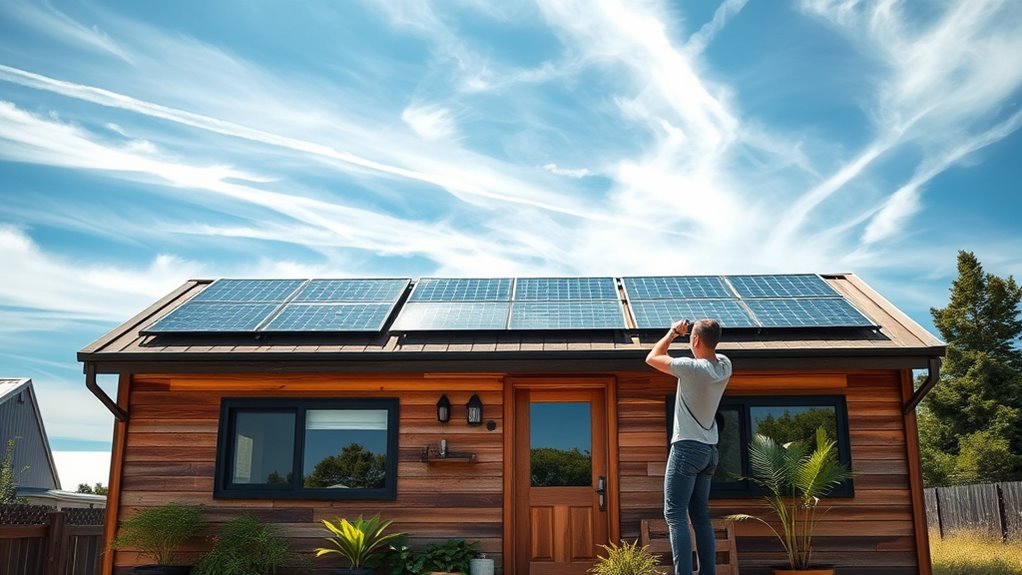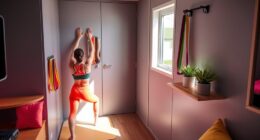To install solar panels on your tiny house roof, assess your roof’s structure, orientation, and space to guarantee ideal placement. Choose lightweight, durable mounting brackets that suit your roof material and ensure secure attachment to withstand weather. Position the panels facing south with proper tilt angles for maximum sunlight, and seal around mounts to prevent leaks. Correct wiring and system integration are essential for reliable energy production. Keep exploring to learn how to maximize your tiny house’s solar efficiency.
Key Takeaways
- Assess roof structure, orientation, and available space for optimal solar panel placement on tiny houses.
- Choose lightweight, durable mounting systems compatible with your roof type to secure panels effectively.
- Position panels south-facing with appropriate tilt angles to maximize sunlight exposure and energy production.
- Seal mounts properly to waterproof the roof and prevent leaks over time.
- Select high-efficiency panels suitable for limited roof space and integrate wiring for safe, reliable system performance.

Installing solar panels on tiny house roofs is an excellent way to increase energy independence and reduce your carbon footprint. When you consider solar panel mounting, you’re taking a proactive step toward making your tiny house more self-sufficient. Proper mounting is essential because it ensures your solar panels stay secure and perform at their best over time. You’ll want to evaluate your roof’s structure, orientation, and available space to determine the best mounting method. Whether you opt for ground-mounted systems or roof-mounted options, secure attachment is key to withstanding weather conditions like wind or snow. Lightweight, durable mounting systems are often preferred for tiny houses to minimize added weight without sacrificing stability.
As you plan your tiny house energy setup, keep in mind that the size and placement of your solar panels directly impact their efficiency. Ideally, you’ll want to position them where they receive maximum sunlight exposure throughout the day—usually south-facing if you’re in the northern hemisphere. Tilt angles should also be considered to optimize energy capture based on your location. When installing, ensure your solar panel mounting brackets are compatible with your roof material, whether it’s metal, shingle, or another surface. Proper sealing and waterproofing around mounts prevent leaks and damage, extending the lifespan of both your roof and your solar system. Additionally, understanding the roof’s structure helps ensure your mounting system is both secure and effective over the long term.
Choosing the right solar panels for a tiny house involves balancing efficiency, size, and cost. Monocrystalline panels tend to be more efficient and space-saving, making them ideal for small roofs. You’ll also want to think about wiring and connections; integrating your panels into your tiny house’s electrical system should be straightforward but reliable. A well-designed solar array can generate enough power to run your essentials, from lighting and appliances to a small water heater. With a properly configured system, you’ll reduce reliance on grid power and enjoy the benefits of off-grid living.
Frequently Asked Questions
How Do I Maintain Solar Panels on a Tiny House Roof?
You should regularly maintain your solar panels by performing panel cleaning to remove dirt and debris, ensuring maximum efficiency. Check wiring inspections periodically to spot any loose connections or damage early. Keep the panels free of snow or leaves, and avoid walking on them. By staying on top of these tasks, you’ll keep your tiny house solar system running smoothly and extend its lifespan. Regular maintenance helps you get the most out of your investment.
Can I Install Solar Panels Myself or Need Professional Help?
You can definitely do a DIY installation of solar panels on your tiny house roof if you have basic skills and some handyman experience. However, for safety, proper wiring, and maximum performance, seeking professional assistance is wise, especially if you’re unfamiliar with electrical work or building codes. This ensures your solar setup is safe, efficient, and compliant, giving you peace of mind and reliable energy for your tiny home.
What Is the Lifespan of Tiny House Solar Panels?
Your tiny house solar panels typically last around 25 to 30 years, with most experiencing about 0.5% panel degradation annually. That means after three decades, they’ll still produce roughly 85% of their original power. Replacement intervals usually fall around 10 to 15 years for best efficiency, but with proper maintenance, your panels can continue powering your tiny home for decades, keeping energy costs low and sustainability high.
How Do Weather Conditions Affect Tiny House Solar Panel Efficiency?
Weather conditions impact your tiny house solar panel efficiency markedly. Solar panel shading from clouds or nearby trees reduces sunlight exposure, lowering output. Seasonal variations mean you’ll get less power during winter months due to shorter days and lower sun angles. To maximize efficiency, keep panels clear of shading, and consider adjustable mounts or tracking systems to adapt to seasonal changes, ensuring you get the most energy year-round.
Are There Specific Permits Required for Tiny House Solar Panel Installation?
Ever wondered if you need permits for your tiny house solar panels? Yes, you do. Permit requirements vary depending on your local regulations, so it is crucial to check with your city or county authorities before installation. Some areas might require building permits or inspections, especially if the system connects to the grid. Ignoring these rules could lead to fines or future issues, so always verify what permits are needed for your tiny house setup.
Conclusion
Installing solar panels on your tiny house roof symbolizes more than just energy savings; it represents your commitment to a sustainable, independent lifestyle. As the panels soak up sunlight, they mirror your hope for a brighter, greener future. Each ray captured is a reminder that even small acts can create powerful change. Embrace this step, and let your tiny house shine as a beacon of eco-conscious living, inspiring others to follow your luminous path.









